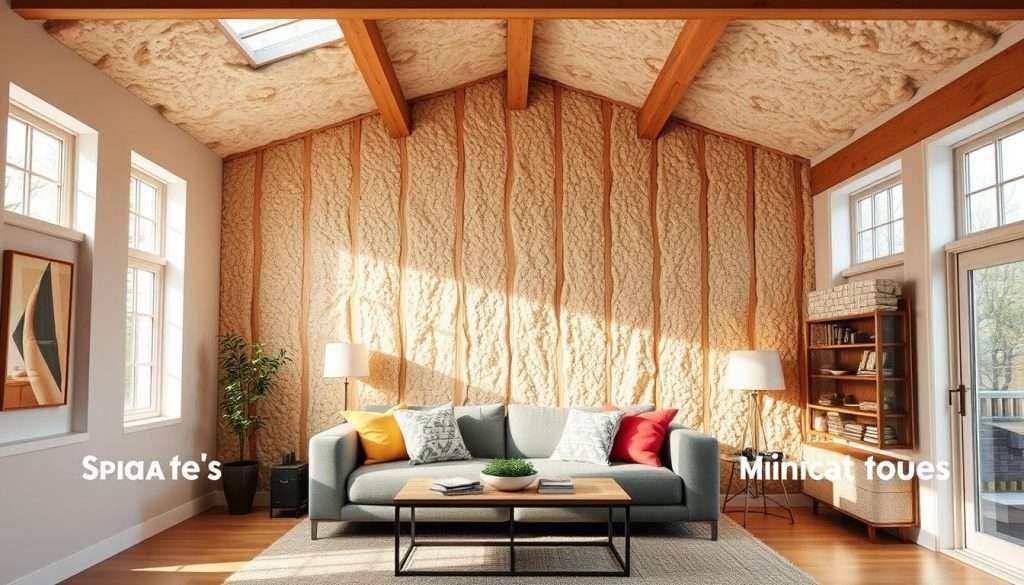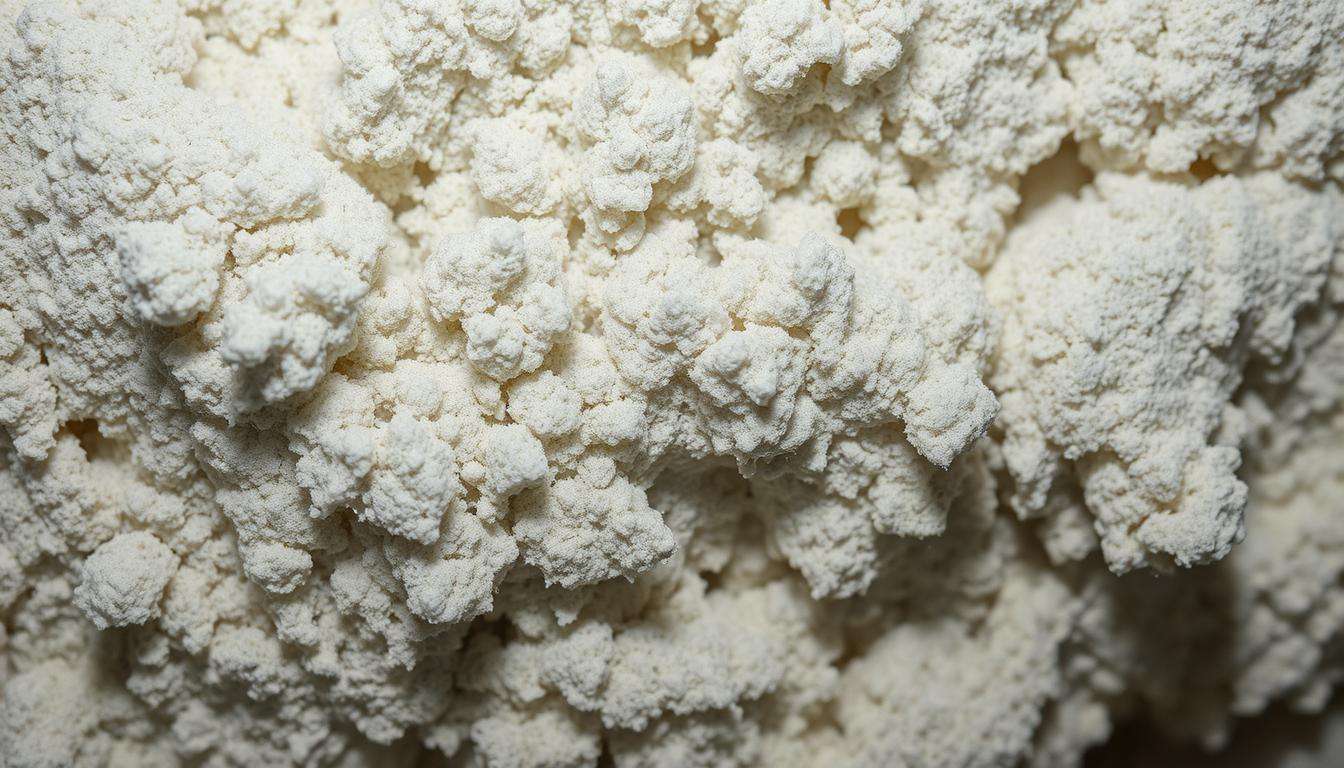Knowing what asbestos insulation looks like is key to keeping your home safe. Asbestos insulation is found in homes built before 1990. It’s dangerous, so it’s important to know how to spot it. This guide will help you learn how to identify asbestos insulation.
You’ll learn about its color, texture, and forms. This knowledge will help you check your home and take safety steps. Knowing what asbestos insulation looks like helps keep your family safe.
Key Takeaways
- Asbestos insulation often has a greyish-brown or silvery-gold color.
- Vermiculite insulation may look like small pebbles, commonly found in homes.
- Older homes, particularly those built before 1990, are more likely to contain asbestos insulation.
- Identifying asbestos insulation is a vital step in ensuring home safety.
- Asbestos insulation can release harmful fibers if disturbed, posing health risks.
- Many safe insulation options exist that have no asbestos content.
Understanding Asbestos Insulation: An Overview
Asbestos insulation has been used in buildings for a long time. It’s strong and keeps heat out. But, it can be harmful to our health.
What Is Asbestos?
Asbestos is a type of mineral that looks like fibers. It’s good at stopping heat and electricity. But, it’s very dangerous when we breathe it in.
History of Asbestos Use
People have used asbestos for thousands of years. But, by the late 1970s, we knew it was very harmful. Companies like Johns Manville had to pay a lot of money to help people affected by it.
Common Uses in Homes
Asbestos was used in many ways in homes. It was in walls, floors, and pipes. Knowing this helps us understand older homes better.
- Wall insulation
- Floor coverings
- Pipe insulation
- Ductwork insulation
Older homes might still have asbestos. Knowing about it helps us take care of our homes.
| Asbestos Insulation Type | Common Uses | Manufacturing Timeline | Health Risks |
|---|---|---|---|
| Sprayed Insulation | Ceilings, walls | 1880s – 1974 | High potential for fiber release |
| Pipe Insulation | Pipes, HVAC ducts | 1910s – 1980s | Medium to high risk |
| Vermiculite Insulation | Attics, walls | 1920s – present | High potential for asbestos contamination |
| Asbestos Paper | Wrapping, lining materials | 1880s – 2000 | Medium potential for fiber release |
Visual Characteristics of Asbestos Insulation
Knowing how to spot asbestos insulation is key for homeowners. It helps find risks in your home. Let’s look at the colors, textures, and shapes of this material.
Color Variations
Asbestos insulation comes in many colors. This helps us spot it. Common colors are:
- Grayish-brown
- Silvery-gold, especially in vermiculite insulation
- White, often in pipe insulation
These asbestos insulation colors tell us about the material. They also hint at health risks.
Texture and Appearance
Asbestos insulation can feel soft or hard. For example:
- Loose-fill insulation is soft and fluffy.
- Pipe insulation is smooth, sometimes with tape.
- Block insulation has rectangular batts with small fibers.
Knowing these details helps us spot asbestos in our homes.
Shapes and Forms
Asbestos insulation has many shapes and forms. Each has its own look. Key types are:
- Loose-fill insulation found in attics.
- Pipe insulation wraps around pipes.
- Spray-on insulation is on ceilings and walls.
Types of Asbestos Insulation Materials
As homeowners, knowing about asbestos insulation is key. There are many asbestos insulation types found in homes. Knowing them helps spot dangers and how to handle them.
Pipe Insulation
Pipe insulation is common in old homes. It looks like a wavy material around pipes. It can be on both hot and cold pipes. It might have 15% to 100% asbestos, often more.
Spray-On Insulation
This insulation looks like a thick, textured coat. It’s on ceilings, walls, or steel beams. It’s 80% to 85% asbestos, used in commercial buildings. It can break down, releasing harmful fibers.
Batt Insulation
Batt insulation is in board form and might be all asbestos. It’s in walls and floors for warmth. As it gets old, it can crumble, releasing asbestos particles.
| Insulation Type | Common Locations | Asbestos Content |
|---|---|---|
| Pipe Insulation | Around water and steam pipes | 15% to 100% |
| Spray-On Insulation | Ceilings, walls, steel beams | 80% to 85% |
| Batt Insulation | Walls, floors, ceilings | Varies (potentially 100%) |
How to Identify Asbestos Insulation in Your Home
Looking for asbestos insulation in your home needs careful eyes and knowledge. Many old homes have asbestos, especially vermiculite from Libby, Montana. Knowing these signs helps you stay safe and aware.
Key Signs to Look For
- Vermiculite insulation looks grayish-brown or silvery-gold, like small pebbles.
- Asbestos air-cell insulation around pipes is off-white or gray, like cardboard or paper.
- Fluffy asbestos wool insulation feels like wool.
- Small, hairlike fibers in block insulation mean it might have asbestos.
- Spray foam insulation is gray and bumpy, like wool.
Inspecting Insulation Materials
When checking insulation, follow safe identification practices to avoid risks. Don’t touch materials that might be harmful. Look at:
- Where insulation is found: attics, around pipes, and crawl spaces.
- When insulation was installed to see if it was during asbestos use.
- How materials look and feel for signs of asbestos.
Safety Tips for Identification
Wearing the right safety gear is key. Here’s how to stay safe while identifying asbestos insulation:
- Wear a mask or respirator to block asbestos fibers.
- Wear protective clothes to avoid touching insulation.
- Use gloves and eye protection with insulation that might have asbestos.
- If you think it’s asbestos, get a pro to test it.
Knowing safety is crucial when finding asbestos insulation. It helps you take care of your home.
| Insulation Type | Appearance | Asbestos Content |
|---|---|---|
| Vermiculite | Grayish-brown or silvery-gold pebbles | Often contains asbestos |
| Air-cell insulation | Off-white or gray, like cardboard | May contain asbestos |
| Wool insulation | Fibrous or fluffy texture | Can contain asbestos |
| Spray foam insulation | Gray, bumpy, fibrous | May contain asbestos |
| Fiberglass | White, fluffy | No asbestos |
Risks and Dangers of Asbestos Insulation
Asbestos insulation is very dangerous. It’s important to know the health risks of asbestos. When it’s disturbed, tiny fibers can get into the air.
This can cause serious health problems over time.
Health Risks Associated with Asbestos
Asbestos is linked to serious diseases like asbestosis, lung cancer, and mesothelioma. People who work with asbestos face a higher risk of dying from these diseases. Even a short time of exposure can lead to cancer.
This is why it’s crucial to watch out for asbestos in homes.
Legal Implications of Asbestos Removal
Removing asbestos insulation comes with legal rules. You must follow local, state, and federal laws. Breaking these rules can result in big penalties.
This makes dealing with asbestos very complicated.
Long-Term Consequences of Exposure
Long-term exposure to asbestos can cause serious health issues. The risk of getting sick from asbestos grows over time. It’s key to deal with asbestos exposure quickly.
Homeowners should talk to experts for safe handling options. For more info, visit this resource.
Professional Assessment and Testing
Knowing when to get help with asbestos in your home is key. Many people don’t know what to do, especially during renovations. They might suspect old insulation. Knowing when to call an expert is important.
When to Call an Expert
Here are times when you should get a professional to check for asbestos:
- If your home was built before the late 1970s, it might have asbestos insulation.
- During any home renovation, especially if insulation materials are exposed.
- If you find vermiculite insulation in your attic, it might have asbestos.
- When you suspect contamination but can’t see it, as fibers are tiny.
What to Expect During an Inspection
Experts will do a detailed check during an asbestos assessment. They will:
- Visual Inspection: Look at areas where asbestos might be.
- Sampling: Take samples if needed.
- Laboratory Analysis: Test samples to see if asbestos is there.
- Reporting: Give you a detailed report and what to do next.

Getting a professional for asbestos testing is safe and reassuring. It helps protect you and your family from health risks.
Safe Removal and Abatement Practices
Removing asbestos insulation safely is very important. You can do it yourself or hire experts. Knowing the right steps and safety measures is key.
DIY vs. Professional Removal
Choosing between DIY and hiring pros for asbestos removal is a big decision. DIY might save money, but it’s risky. Experts have the skills and safety gear needed.
Doing it wrong can harm your health, cost a lot, or even get you in trouble with the law.
Steps for Safe Handling
If you’re doing the removal yourself, follow these safety steps:
- Wear the right protective gear like a mask, gloves, and coveralls.
- Use plastic sheets to keep the area sealed and prevent fibers from spreading.
- Moisten the insulation a bit to reduce dust and fibers when you remove it.
- Bag the asbestos waste carefully and label it right.
- Dispose of it according to local rules for hazardous materials.
Post-Removal Protocols
After removing the asbestos, follow these steps to keep things safe:
- Clean the area well with a HEPA vacuum.
- Test the air to make sure no asbestos fibers are left.
- Keep records of the removal and air tests for future checks and safety rules.
The goal is to handle asbestos safely from start to finish. This keeps everyone healthy and makes a safe home.
Regulations and Guidelines Surrounding Asbestos
It’s important to know about asbestos rules to stay safe at home and work. The government has clear guidelines for handling asbestos. These rules help keep everyone safe from asbestos dangers.
Federal Regulations
The federal asbestos guidelines tell us how to deal with asbestos in the U.S. Key rules include:
- OSHA standards for workplace safety
- Environmental Protection Agency (EPA) guidelines for handling and throwing away asbestos
- Rules for different types of asbestos work, showing how to remove and manage it
State-Specific Guidelines
States have their own rules that add to federal asbestos laws. It’s key to follow these state-specific guidelines because they can change a lot. Important things to know include:
- Different rules for who can work with asbestos
- When you must tell people before removing asbestos
- How to throw away asbestos materials
Importance of Compliance
Following asbestos regulations is very important. It keeps you and your family safe from asbestos dangers. These dangers can cause serious health problems like lung cancer.
Knowing and following the rules makes it easier to safely fix or remove asbestos. It also helps avoid legal trouble for homeowners and workers.
| Asbestos Work Class | Description |
|---|---|
| Class I | Removal of thermal system insulation and surfacing ACM and PACM. |
| Class II | Removal of ACM not classified as thermal insulation or surfacing. |
| Class III | Repair and maintenance likely to disturb ACM. |
| Class IV | Maintenance activities where ACM is handled but not disturbed. |
Asbestos Alternatives for Insulation
Homeowners looking to replace old asbestos insulation have many safe options. These modern materials meet safety and efficiency needs. They avoid the health risks of asbestos.
Modern Insulation Materials
Many materials are now good asbestos alternatives. Here are some:
- Cellulose Insulation: Made from recycled paper, it’s cost-effective and good for the environment. It comes in different types.
- Fiberglass: It’s made from recycled glass and is fire-resistant. It’s a good choice for avoiding asbestos.
- Mineral Wool: It’s made from natural or recycled materials. It doesn’t need harmful chemicals for fire safety.
- Polyurethane Foam: It’s been used since the late 1960s, often in roofing.
- Natural Materials: Hemp, sheep’s wool, and treated cotton are eco-friendly options. They can improve insulation.
Benefits of Asbestos-Free Insulation
Choosing insulation without asbestos has many benefits:
- Health Safety: It reduces the risk of serious health problems, like cancer.
- Installation Ease: Modern materials are lighter and easier to install than old insulation.
- Environmental Impact: Options like cellulose and mineral wool are sustainable because they use recycled materials.
- Longevity and Performance: Fiberglass and mineral wool are more efficient at keeping heat in or out.
Cost Comparison
Knowing the cost of insulation is important for homeowners. Here’s a table comparing costs:
| Insulation Type | Average Cost per Square Foot | Durability | Environmental Impact |
|---|---|---|---|
| Asbestos Insulation | $1.50 – $3.00 | Long-lasting under proper conditions | Negative, hazardous to health |
| Cellulose Insulation | $0.60 – $1.20 | 10 – 30 years | Positive, eco-friendly sourcing |
| Fiberglass Insulation | $0.50 – $1.00 | 15 – 50 years | Neutral with potential for recycling |
| Mineral Wool | $0.70 – $1.50 | 10 – 30 years | Positive, often made from recycled materials |

Frequently Asked Questions about Asbestos Insulation
Let’s clear up some common myths about asbestos insulation. Many think you can tell if a material has asbestos by its color. But, the only sure way to know is through professional testing in a lab.
Older homes might have materials that look like they have asbestos. But, only a lab test can say for sure. For example, pink insulation usually doesn’t have asbestos.
When talking to experts about asbestos, ask the right questions. Make sure they are trained and know how to handle asbestos. The EPA says to hire experts to check materials before you start any work.
This helps you understand the risks and what steps to take next. It’s important to have a good conversation about this.
Homeowners have many resources to help them. The EPA and non-profit groups offer lots of information. They can help you decide what to do about asbestos in your home.
